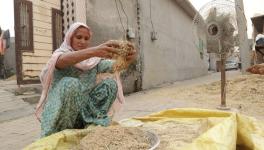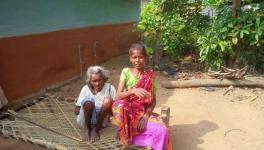The Long Shadow of Hunger in India
The COVID-19 pandemic and the government’s ill-conceived and heartless response have left the people of India devastated. The unprecedented loss of jobs and earnings due to repeated lockdowns pushed a large section of the people to the brink of starvation. Meanwhile, a fumbling administration provided inadequate relief in terms of food grains and some financial help for a few months to only a section of the people. Chilling stories of people eating grass and wild tubers, begging for food from neighbors and charities, taking loans on brutal interest rates just to survive, or simply cutting down on meals emerged from across the vast country. Among the worst hit were the most marginalized communities like forest-dwelling tribals, landless agricultural workers, industrial workers whose factories remained closed, and the vast segment of the population that depends on daily wage work in informal services or sectors like construction and hospitality.
Bhuwaneshwari, belonging to the forest-dwelling Pulayar community, lives with her family inside the Anamalai Tiger Reserve in the southern Indian State of Tamil Nadu. Unable to sell forest produce due to lockdown restrictions or access the government relief without a family ration card, they survived on porridge made from wild tubers during the lockdown in April and May 2021.

Bhuwaneshwari and her family in the south Indian State of Tamil Nadu and survived on porridge made from wild tubers during the lockdown in April and May 2021. Photo: Sruti MD
“I walk 10 km into the forest every morning to collect produce. It takes me around two hours to reach our spot. We start at 8 am and return by 5 pm. During the lockdown, we harvested groundnuts. We stocked it up in the hope that we could take it down later and sell it at the mandi (market),” Bhuwaneshwari told Newsclick.
“How long can we go on surviving on these tubers?” she asked in desperation.
Like many other tribal communities in India, their only source of income is minor forest produce. The suspension of the public transportation system during the lockdown severed their source of livelihood and cut them off from the rest of society. More than 40,000 such tribal families in Tamil Nadu do not have a ration card, which would entitle them to subsidized food grain.
Record harvest, yet agri-workers hungry
Landless workers and marginal farmers also faced the brunt of the crisis. Although farming continued through the year and India produced a record harvest of food grains – some 395 million tonnes – wages of agricultural workers and the meager returns of marginal farmers fell, and indebtedness increased. There are over 140 million landless laborers in India.
Mohammad Khan, a marginal farmer of South 24 Parganas district of West Bengal State, owns 2.5 bighas (about 0.4 acres). He leases out 1.5 bighas and grows vegetables on the rest. The lockdown and restrictions saw him struggle for food because transportation for his meager vegetable crop was unavailable.

Mohammad Khan, whose hut was damaged by Cyclone Yaas in May, weaves a net to catch fish. Photo: Sandip Chakraborty
“Hunger is perennial in my hut. Skipping meals is a regular habit”, he said. Cyclone Yaas, which hit the coastal region in May, damaged his ramshackle hut. His patch of land was inundated, dealing a blow to any chances of escaping from the grip of hunger.
S Somas, an agricultural worker in the Kanyakumari district of Tamil Nadu, solely depends on daily wages earned from working in the paddy fields or banana and rubber plantations. But he and his family suffered immensely during the two lockdowns in March 2020 and April 2021 due to fewer workdays and inadequate government support.
“Since March 2020, the number of days we have worked has reduced considerably. The Mahatma Gandhi National Rural Employment Guarantee Act (a rural job guarantee program) was also stopped for a considerable part of the last year,” Somas said.
“The farmers suffered losses due to the fall in prices. We depend on them for their jobs, and so our income was hit as well,” he added.

Raghu and his family, who hail from the State of Karnataka, are migrant workers in the State of Tamil Nadu. They say that they have not received any support from the government and no political party bothered about them since they are not registered voters. Photo: A. Neelambaran.
India was suffering from chronic and pervasive hunger even before the pandemic struck. According to a 2020 estimate by the Food and Agriculture Organisation (FAO), at least 189 million Indians suffered from severe hunger. The Global Hunger Index 2020 placed India at 94th position among 107 countries afflicted by mass hunger. The National Family & Health Survey of 2015-16 found that 59% of children up to the age of five were anemic, as were 53% of all women. Over 38% of children were stunted, and nearly 20% were wasted – both indicators of chronic malnutrition. What the pandemic did was to worsen the situation, and the government had no answer.
Urban India too suffered
It was not just rural areas – where nearly two-thirds of Indians live – that suffered. In urban areas, the harsh lockdown restrictions, brutally enforced by the police, and the free hand given to employers to dismiss workers without any financial compensation left millions on the verge of complete destitution and even death. Urban areas also have millions of informal workers, including personal service providers and small shopkeepers, vendors, and maintenance personnel, in addition to industrial workers.
Mitesh Prajapati, a 30-year-old diamond polishing worker in Surat, Gujarat, was the sole earning member of his family of four. After the lockdown last year, he could not get any work, like many others in the sector. The family managed to survive for seven months by borrowing food from neighbors or taking loans. But Prajapati was struggling to provide for the treatment of his ailing mother. In early July last year, he fell ill and was advised to get tested for COVID-19. However, Prajapati, unable to bear the added expense of his treatment, jumped into a river on July 4, 2020, embracing death rather than the pain of living.
“He was under immense mental pressure. Apart from the usual expenses, our mother is ailing and needs medicines every month. When the doctor suggested he might have COVID-19 and should get tested, he saw it as another expense and couldn’t bear the thought of it,” Hitesh Prajapati, his brother, told Newsclick.
In Aligarh, a city in the northern State of Uttar Pradesh, Newsclick found 43-year-old Guddi, the mother of five children, at the District Hospital after battling intense hunger for over two months. Her husband, the sole breadwinner in the family, died of Covid-19 last year, forcing her to earn a living as a factory worker for Rs 4,000 (USD 54) per month. But a few months ago, the factory shut down due to the lockdown. Her eldest son Ajay (22) began working for daily wages at a construction site, but the second wave snatched away that job. Gradually, their savings got exhausted.
“Hunger and disease affected us so much that we could not walk or talk properly. The situation became worse after our neighbor stopped giving anything. We would beg them for food, but how long could they feed us when everyone was struggling,” a distraught Guddi, who is now stable, recalled. She talked about how her entire family survived only on water for days on end. They were finally rescued by a local NGO and taken to the hospital.
Informal sector workers suffered in these areas too. Vimla Devi, a domestic worker in Bhopal in Madhya Pradesh State, and her husband, a construction worker, both lost their jobs. With two toddlers to look after, she bitterly complained about not receiving any help from the government.
“The second wave of the lockdown virtually pushed us to the brink of starvation. If NGOs and social groups had not come forward to help, we would have died of hunger by now,” Ram Suresh Yadav, president of National Federation of Railway Porters, told Newsclick in Lucknow, the capital of Uttar Pradesh.
Neeru from Samba in Jammu & Kashmir summed up the desperation while talking about her 63-year old father Deshraj Kumar, who used to sell vegetables but lost his income during the lockdowns, ran up an enormous debt, and now washes utensils at weddings.
“There were days when he thought it’s better to end his life than to survive like this. But I kept assuring myself that things would be fine. But I was wrong. How will we pay off our debt? We have no savings. And the coronavirus doesn’t seem to go away. I don’t want him to starve again,” she said.
Warehouses overflowing with food grains
If India had such a bountiful harvest, how were people suffering from hunger at this scale? Driven by the record foodgrain output, government warehouses were overflowing throughout the pandemic. According to the government’s own monthly data, during April and May 2020, when the harsh lockdown was in place, the foodgrain stocks were 57 million tonnes and 64.4 million tonnes, respectively. This is 2-3 times the statutory stocking norms which include strategic reserves. Yet, the government refused to distribute the grain. It announced that only 5 kg of rice/wheat would be given in addition to the usual quota of grain given through the public distribution system. Not only was it insufficient, but it ignored the harsh reality that people didn’t have oil, fuel, etc., to cook the food. In June 2021, food grain stocks were at a record high of nearly 91 million tonnes. Yet, the government continued to hold on to it, refusing to distribute it to hungry people.
Trade unions repeatedly demanded that essential items such as cooking oil be included in the public distribution system. However, this went unheeded, as did the demand for some cash help to families.
Struggle for Relief – And Change
As the country’s people reeled under the deadly pandemic and governments abandoned them to their fate, the Left forces emerged as the most consistent fighters for lives and livelihoods. There were widespread agitations for universalising the public distribution system, expanding the commodities covered under it, increasing additional foodgrains to 10 kg per person per month (from the 5 kg being given), providing direct financial support of Rs. 7500 (USD 100) per month for all non-income tax-paying families, and withdrawal of anti-people laws passed by the Central government. Despite the restrictions due to the pandemic, protests in workers’ residential areas and factory gates were held throughout last year, and on November 26, an all-India general strike was successfully observed. Since November, farmers too have been on the roads against the imposition of corporatization in the farming sector through three controversial laws. These different strands of resistance have coalesced now.
Left organisations have also been at the forefront of providing relief material to distressed families. This has been done in an exemplary fashion by the Left-led State government of Kerala. Within the first two weeks of the lockdown, 1,255 community kitchens were set up by volunteers, which provided around 280,000 meals a day. In the initial lockdown period, before the grocery and ration kits supplied by the State government started reaching the households, these kitchens were the primary means by which Kerala ensured that its people were hunger-free. Community kitchens became a boon for nearly 500,000 migrant workers (called ‘guest workers’ in Kerala), unlike in other States where migrants suffered heavily. The State government also set up more than 1,000 Janakeeya Hotels (People’s Hotels), which provide meals at subsidised rates.

A community kitchen run by the local self-governing body in the city of Thiruvananthapuram in the State of Kerala: Photo: Subin Dennis
Besides the government’s efforts, left and progressive organisations distributed relief material, including food and daily use items like soap, to destitute families. For instance, the Democratic Youth Federation of India actively continued its Hridayapoorvam project, providing lunch to patients and their attendants in government medical college hospitals. The activists of the organisation also took steps to provide packed meals and groceries to those in need. Kerala’s success in tackling food insecurity during the pandemic is as much due to community efforts as efficient administration. In West Bengal, ‘Red volunteers’ mobilized on a massive scale to help those suffering by arranging medical attention and providing daily food necessities.
Similarly, the Centre of Indian Trade Unions provided kits of food and necessities in almost all of India’s States over three months with the help of donations from the people.

A scene at a community kitchen in the State of West Bengal. Photo: Sandip Chakraborty
The economic crisis created by the Modi government has been characterised by high levels of unemployment and a lack of food and basic rights like healthcare and education for a large mass of people. At the same time, the top echelons of society, especially corporate bigwigs, have accrued huge profits. This extreme inequality has created a simmering sense of anger and discontent that will play out in the coming months.
[With reporting by Neelambaran A and Sruti MD in Tamil Nadu; Sandip Chakraborty in West Bengal; Abdul Alim Jafri in Uttar Pradesh; Damayantee Dhar in Gujarat; Azhar Moideen in Kerala; Kashif Kakvi in Madhya Pradesh; and Sagrika Kissu in Jammu & Kashmir]
Hunger in the World is a collaborative series produced by ARG Medios, Brasil de Fato, Breakthrough News, Madaar, New Frame, Newsclick and Peoples Dispatch.
Get the latest reports & analysis with people's perspective on Protests, movements & deep analytical videos, discussions of the current affairs in your Telegram app. Subscribe to NewsClick's Telegram channel & get Real-Time updates on stories, as they get published on our website.
























